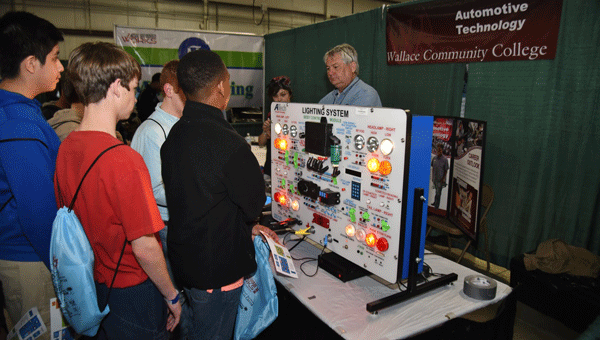Southeast Ala. Works aims to bolster region’s workforce
Published 8:33 pm Wednesday, September 20, 2017

- A group of interested eighth graders from around the Southeast Alabama region learn about lighting systems from Wallace Community College’s automotive technology program during a previous Southeast Worlds of Work event.
In 2015, the Alabama state legislature organized the Regional Workforce Councils (RWC) to serve as a bridge between the Alabama Department of Commerce and the workforce challenges happened on a state and regional level.
Today, the RWC is seeking to accomplish just that with a boots-on-the-ground approach encompassing business owners, industry specialists and students.
The state has been split into seven regional workforce councils. Butler County occupies the sixth region, dubbed Southeast Alabama Works, which also includes Crenshaw, Pike, Covington, Coffee, Geneva, Barbour, Dale, Henry and Houston counties.
Ryan Richards, director of workforce development for Southeast Alabama Works, made his region’s mission statement explicitly clear.
“What we’re hoping to be able to do is build pipelines that allows people to be able to walk into any job and any industry and have some sort of knowledge or training prior to earning that job,” Richards said.
“It cuts down on costs for training, and it cuts down on not having qualified employees.”
The first of a multi-pronged approach includes a desire to ramp up career tech programs around the region and drive students to high-wage, high-demand jobs immediately after high school.
State legislature has asked each region to develop two industry focal points.
Transportation/distribution was the first, and potentially highest, priority.
“The No. 1 need in the state of Alabama is for CDL-licensed drivers,” Richards said. “It’s amazing to know the needs of those industries because we don’t have a pipeline or that, and that industry is starting to hurt because there are not as many people out there willing to get in a semi and drive across the country for a week and come back.”
Heating, ventilation and air conditioning (HVAC) industries are the second, and a third—aviation—is in the works.
Students are the final and most important target of Southeast Alabama Works, particularly students in grades 8-12 who have yet to decide on a career path.
One of the organization’s biggest goals is to communicate to young students that glamor does not necessarily equal wealth when it comes to a career.
“You’ve never met a broke welder,” Richards said. “You’ve never met a broke HVA technician. You’ve never met a broke electrician. Those are just things that people don’t see as great careers, but the opportunities are endless. You can make a really good living. We’re just letting the kids know that what used to be considered blue-collar careers are cool again.
“We’re not trying to downplay the four-year colleges, but 80 percent of jobs don’t require a four-year degree. So what about those students who don’t have the financial resources or the foundational education skillset to go on to a four-year university and earn a degree? How are we communicating to those students that they can stay right here in their own community and make a living with a skillset that can pay off in the long run?”
To that end, on Feb. 21-22 of next year, the National Peanut Festival Fairgrounds in Dothan will once again be the site of the third annual Southeast Worlds of Work (Wow) event, formerly known as Wiregrass Works.
The event, will bring 6,000 eighth graders from 100 different schools in 16 counties spread across three states to receive hands-on experiences with nearly a dozen different disciplines, including health care, HCAV, trucking, and more.
Those interested in participating can visit southeastwow.org for more information.





